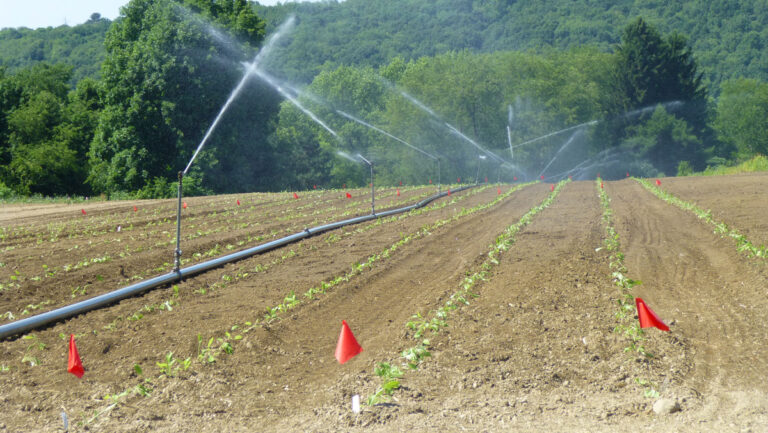Water infiltration (sometimes soil infiltration or just infiltration) is how water on the ground surface enters the soil.
It is one phase of a larger process known as the hydrological cycle, or water cycle, which encompasses the continuous movement of water on, above, and below the surface of the Earth.
When water infiltrates the soil, it moves downward through the soil profile, replenishing groundwater and providing essential moisture for plant roots. As it does this, soil moisture is maintained. Water that infiltrates soil will not be causing the soil erosion associated with surface runoff.
In this guide, we’ll go over the details of water infiltration, the factors influencing it, and how you can improve your soil’s water infiltration rate.
What is the Water Infiltration Rate?
The rate and efficiency of water infiltration are governed by various factors, including soil texture, structure, organic matter content, vegetation cover, and land management practices.
Soil’s water infiltration capacity is defined as its maximum rate of infiltration. It is most often measured in inches per hour but can be measured in meters per day or other rates as necessary. This rate will decrease as the moisture content of the soil’s surface layers increases. Once the rate of precipitation exceeds the infiltration rate, runoff will occur.
Key Factors Affecting Water Infiltration Rate
The factors that affect the infiltration rate can be split into two categories, inherent and dynamic.
Inherent Factors
These are factors inherent in the soil or landscape. They won’t change over time. They include the soil texture (the proportion of sand, silt, or clay) and clay mineralogy.
- Slopes: Landscapes situated on steep slopes are prone to runoff and erosion.
- Sandy Soil: Water moves more quickly through porous materials like sandy soil than clayey soil, especially compacted clay with little structure or aggregation.
- Clayey Soil: Certain types of clay will shrink and crack as they dry. These soils have high infiltration rates since they have natural conduits for water to enter the soil. Absent these cracks, their infiltration rate will be characteristically slow.
Dynamic Factors
Dynamic factors don’t remain constant, so they’ll need to be watched and adjusted for over time.
- Existing Water Content: The more water already present in the soil, the lower the infiltration rate will be.
- Cracks and Pores: More openings mean more infiltration, but as the soil gets wetter over time, these cracks will close up, and the infiltration rate will slow down.
- Land Management: Practices that cause surface crusting and soil compaction will affect the water infiltration rate.
How to Measure Water Infiltration Rate
The USDA recommends this procedure (page 7) for measuring infiltration rates on your own using a few fairly easy-to-obtain supplies:
- 6-inch diameter ring
- plastic wrap
- 500 mL plastic bottle or
- graduated cylinder
- distilled water
- stopwatch or timer
This method may be appropriate for small projects. However, if you’re planting a large landscape or interested in infiltration for farming purposes, you may need to contract the services of a professional civil engineer.
Why Soil Infiltration Matters
Soil infiltration is just one aspect of overall soil health. It’s primarily important for the structure and health of the soil, but it also has major importance to the amount of water available within the soil for your plants to use.
Moisture Retention
Adequate infiltration ensures that enough water is in the soil.
This is particularly important in agriculture, where consistent soil moisture is necessary for crop growth and yield. In landscapes like native meadows, water infiltration supports establishing and maintaining vegetation, especially during periods of low rainfall.
Runoff and Erosion Prevention
Efficient infiltration minimizes the water that runs off the surface, known as runoff, which can otherwise lead to soil erosion, loss of nutrients, and sedimentation in nearby water bodies.
For farmers, preventing erosion preserves the topsoil, essential for sustained agricultural productivity. Landscape architects and ecologists also prioritize reducing runoff to maintain the integrity of designed landscapes and natural ecosystems.
Groundwater Recharge
Water infiltrating the soil contributes to groundwater recharge, replenishing aquifers vital for long-term water supply. This is important for agricultural purposes and maintaining base flow in streams and rivers, which supports aquatic ecosystems.
How to Improve Water Infiltration Rates
The inherent infiltration properties of your meadow or farm will affect the methods you can use to improve your water infiltration rates and the rates you can realistically achieve, but improvement is possible.
These methods focus on minimizing soil disturbance and compaction, protecting soil from erosion, and encouraging the development of sound, porous soil.
Increasing Vegetative Cover
Cover crops are often used to maintain vegetative cover in between planting seasons. This can help protect the soil surface from the impact of raindrops, which cause compaction or create a crust that impedes infiltration.
Maintaining a vegetative layer also supports the soil’s microbiome, which improves infiltration rates.
Increasing Soil Organic Matter
Soil organic matter consists of decomposed plant and animal residues, living soil organisms, and other substances synthesized by soil organisms. The presence of this organic matter can improve soil structure and enhance its water-holding capacity.
Incorporating organic amendments such as compost or mulch can increase soil organic matter. Allowing natural leaf litter to decompose on-site in meadows can also help build organic matter.
Managing Crop Residues
Crop residues are plant parts left in the field after harvest, such as stalks, leaves, and roots. These residues protect the soil from erosion and compaction and contribute to increased soil organic matter.
How Ernst Seeds Can Help Improve Water Infiltration Rates
Water infiltration rates are critical for anyone wanting to optimize soil health. Understanding their place in the larger water cycle, the factors that influence those rates in landscapes, and how to improve those rates will lead to better-established meadows that stand the test of time.
However, water infiltration is just one piece of the puzzle when optimizing your next meadow. Choosing and planting the right seeds at the right time is still important.
For 50 years, Ernst Seeds has been developing seed mixes that optimize soil health and contribute to the reclamation of natural environments throughout the eastern U.S. We have the perfect selection of cover crops that can increase your soil’s infiltration rate and produce beautiful, long-lasting native meadows for any project.
Do you have questions about soil health or how to build the right mix? Contact the experts at Ernst today.


